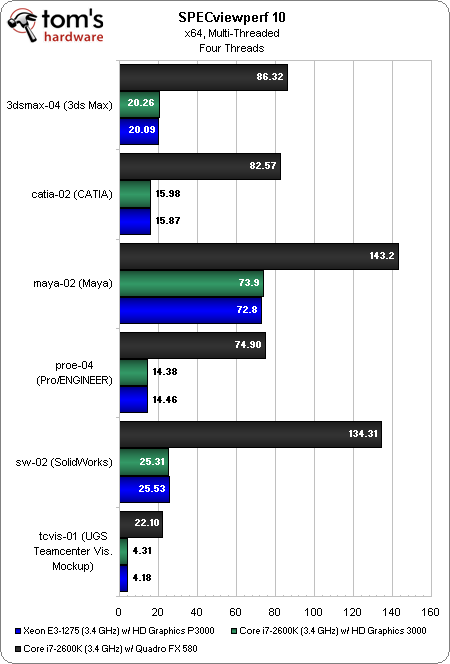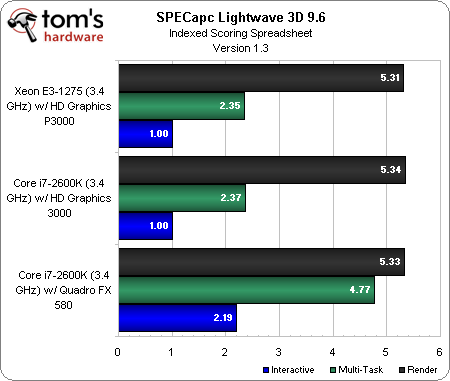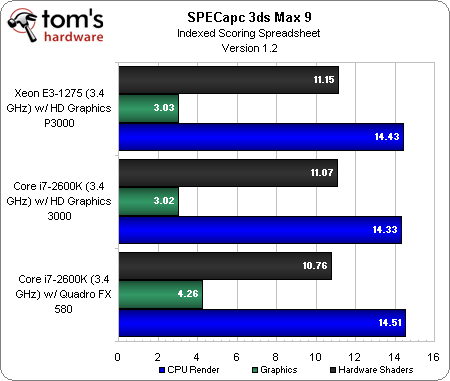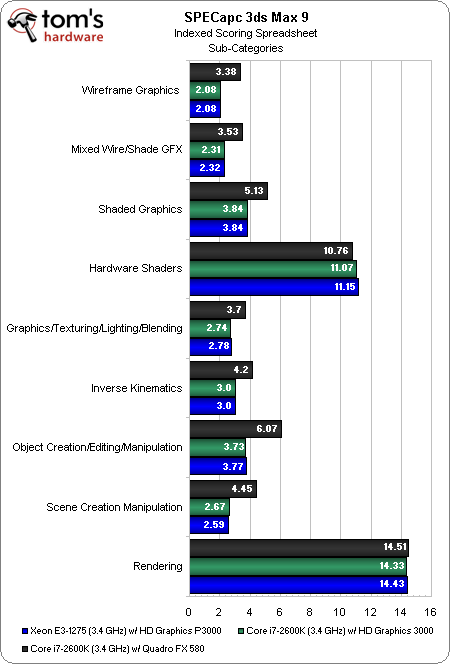Intel Xeon E3-1275 Review: Sandy Bridge Goes Professional
We've already seen Sandy Bridge impress in the desktop space. Does Intel's latest processor architecture have what it takes to dominate the single-socket server and workstation space, too? We run the fastest workstation SKU through our benchmark suite.
Benchmark Results: SPECapc And SPECopc Testing
First of all, it’s important to note that we’re running viewperf 10 because the newer SPECviewperf 11 isn't properly recognized by the HD Graphics P3000/3000 engine, and several of the benchmark's sub-tests consequently fail to yield scores.
Even the results in viewperf 10, however, show the HD Graphics P3000 and 3000 parts performing similarly. Intel’s contention is that it’s optimizing for real-world scenarios where customers will benefit from improved performance, rather than benchmarks. So, we’ll have to see if any of our other graphics-oriented metrics demonstrate the workstation-specific part distinguishing itself.
Meanwhile, Nvidia’s Quadro FX 580 puts down significantly better numbers in all six sub-tests, absolutely warranting an upgrade to the $150 card in five of them. Intel’s processor graphics hold up admirably well in Maya, even though this isn’t one of the apps that the workstation team says it has optimized for yet.
The latest version of LightWave (10) is a significantly different piece of software than LightWave 3D 9.6, the latest build we can test using SPEC’s canned workload. Much of this has to do with input from Rob Powers, the guy who served as the animation technical director for Avatar and is now vice president of 3D development at NewTek. We’ve discussed custom benchmarking tools with Rob in the past, but don’t have anything to show for those talks as of yet. So, we’re still stuck using this much older version of LightWave to test modern graphics hardware.
The OpenGL render test actually shows our three configurations performing somewhat similarly. It’s in the Interactive and Multi-Task benchmarks where Nvidia’s Quadro FX 580 distances itself from Intel’s HD Graphics P3000/3000 products.
That a $150 discrete solution outperforms integrated graphics really isn’t much of a shocker. What’s more interesting is that HD Graphics P3000 and HD Graphics 3000 return similar results. This seems to be yet another app not yet differentiated by Intel’s workstation-specific part.
Given the similar clock rate and Turbo Boost profile of the Core i7-2600K and Xeon E3-1275, similar CPU Render scores in 3ds Max 9 are expected. The fact that Intel’s HD Graphics implementations outmaneuver the Quadro FX 580 in the Hardware Shaders test, however, is a little more surprising. In the final test, graphics, Nvidia’s card reclaims its position on top.
Get Tom's Hardware's best news and in-depth reviews, straight to your inbox.
The sub-category chart breaks the results down further. In just about every category, the Nvidia card outperforms Intel’s best effort (except for the Hardware Shaders test).
There’s actually a bit of good news for Intel, though. While there doesn’t really seem to be any benefit to using HD Graphics P3000 over HD Graphics 3000, there’s also a case for using the processor graphics included for “free,” rather than spending an extra $150 on discrete graphics. Nvidia’s card simply doesn’t have that big of an advantage.
Current page: Benchmark Results: SPECapc And SPECopc Testing
Prev Page Test Setup And Benchmarks Next Page Benchmark Results: Adobe CS5 Suite-
dragonsqrrl one-shotStop teasing and give us a six core Sandy Bridge CPU!Sandy Bridge-E, LGA 2011 X79, Q4 2011.Reply -
agnickolov Finally a compilation benchmark! Now please make it standard in your test suite for CPUs and storage so there's a real benefit from it all for actual comparisons.Reply -
DavC Thanks for this review Chris, very well covered. I'll probably be refering back to this when it comes to spec our next workstations.Reply -
I think this is a useless review. Why are we comparing Apples to Oranges? Lets compare current generation Xeons to Previous generation Xeons.Reply
-
dgingeri one thing I can attest to: companies who cheap out on their workstations and servers never perform well as companies, and eventually fail.Reply
I've worked with many small businesses, and every one that used a desktop chip for a server or a discount chip (Celeron, Duron, etc) for their desktop computers all performed very poorly. Some seemed to hang on by the sheer will of the owner, and in a couple cases, when the owner got sick for more than a week, the businesses folded like lawn chairs.
I've also seen an Engineering shop of ~30 engineers invest nicely into a real server and real workstations, and had me set up their entire network with SBS. their business ramped up so fast and well that they had to hire several more engineers and outgrew SBS (limited to 50 users at the time) within the next 2 years, and I had to go back and rebuild their domain with full enterprise level software, and add another server specifically for email. the owner said the investment in that SBS system was the best thing he'd invested in the business since he hired his first engineer.
Business owners who do not invest in their IT infrastructure fail at business. It's pretty plain and simple. While investing in good IT gear and software doesn't mean you'll ramp up your business to unheard of heights, it does give you a major leg up on the competition. -
given the option of a cheaper Xenon that does not have the P3000 im pretty sure 90% of companies would choose that option, discreet graphics would almost exclusively be employed for the majority of workstation class desktopsReply




